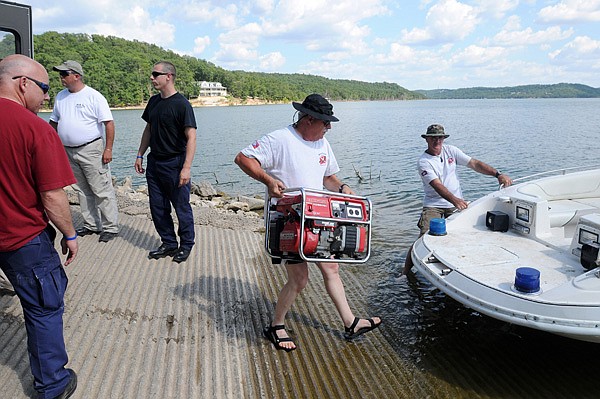Lake Search Continues
OFFICIALS USE CADAVER DOGS TO HELP FIND MISSING TEEN
Doug Gay, Benton County Sheriff’s Office public relations officer, loads a generator Monday onto a sheriff’s office boat to power an underwater camera in a continuing search for a college student who went missing from a boat in the Ventris area of Beaver Lake on Saturday. The underwater camera and two operators were provided by the Baxter County Sheriff’s Office.
Tuesday, July 19, 2011
GARFIELD — Tyler Jeck, 19, a student at Pittsburg State University in Pittsburg, Kan., jumped off a boat into Beaver Lake to “cool off” Saturday and has not been seen since.
The search for the missing teenager entered its third day Monday as cadaver dogs were sent out in boats near the Ventris boat launch.
The launch ramp is in a secluded part of Benton County, south of Garfield at the end of Benton County Road 899 which is also known as Fox Hollow Road.
Jeck was with a group of friends when the incident occurred. One of the group’s parents has a lake house in the area and the group were on a weekend getaway, officials said. A girl was being pulled on a tube when she fell off and the boat stopped to pick her up. That’s when Jeck dove into the water, according to law enforcement officials.
AT A GLANCE
Beaver Lake Drownings
Saturday’s incident is likely the second drowning at Beaver Lake this year, said Alan Bland, a ranger with the U.S. Army Corps of Engineers.
“Our first was in April, a young man from Chicago on spring break,” Bland said. “He drowned near the dam about 3 a.m. Alcohol was found in his system.”
A majority of drownings in the lake are similar.
“The typical victim is a young male, (the drowning occurs) on a Saturday or Sunday and alcohol is involved,” Bland said.
The April death was the 109th drowning in Beaver Lake since the Army Corps started keeping records in 1964, Bland said.
Source: Staff Report
On Monday, authorities worked to narrow the search area by coordinating the 911 cell phone transmissions with GPS coordinates. Officers dropped buoys at points of interest, said Capt. Mike Jones, head of the Benton County Sheriff’s Office Field Division.
A high-resolution, infrared camera from the Baxter County Sheriff’s Office was put in the water Monday afternoon so authorities could look some 80-feet deep where, earlier in the day, a cadaver dog alerted handlers of the possible existence of a body.
The dogs “hit” in the area near one of the buoys, authorities said.
“The dogs are smelling for gases,” explained Jones. “Specifically, methane from a body, or something, decomposing. Some grasses give off similar gases, but this gives us an area to take into consideration.”
The search was centered about 250 yards from the boat launch where sonar from the Johnson County Sheriff’s Office spotted an anomaly on the bottom of the lake between two trees, Jones said. Officials believe the anomaly could be a body.
The trees serve as markers for a search area some 400 square feet in size. The size and depth of water inhibits the search because divers can only work for very short periods at depths of 80 to 100 feet, Jones said.
“Divers can only stay in that depth of water to search for about 5 minutes,” Jones said.
Members of the Benton County and Washington County dive teams were on hand Monday, but that still put only seven divers available.
Lt. Brian Comstock with the Washington County Dive Team said water temperature is a factor when diving at 80 feet because the deeper the water, the colder it gets.
“Plus, you’ve got so much gear on you,” Comstock said. “Once you get down to that depth you’ve got to limit your time because of the nitrogen in your body. Nitrogen can’t escape at that depth like it can on land. Everybody’s different.”
Nitrogen is the gas frequently blamed for the “bends,” or decompression sickness, authorities said.
There is nitrogen in the air we breath and the human body retains a small, constant amount of nitrogen, according to the website scuba.about.com. However, underwater, the body becomes saturated with nitrogen because the gas cannot escape.
As a diver surfaces, the retained nitrogen gas expands and can damage tissue and organs if the expansion is too quick.
“One dive and you’re done for the day at that depth,” Comstock said. “You could do a 20-foot dive, but not another 80-foot dive on the same day. Our dive tables tell us at the 80-foot depth we have 21 minutes. But once you get down there, you have to get your gear set and your orientation straight.”
Additionally, Comstock said, there is zero visibility at 80 feet. With a flashlight, divers can see their gauges, so the search will be by feel, Comstock added.
“Diving in Washington County, in most cases, we’re at 30- to 60-feet deep at the most,” Comstock said. “At that depth, you can have a tender on a rope telling you where to go. At 80 feet, your ropes gets at such an angle, you can’t do that.”
At 10 p.m., Jones said crews were going back out with two cameras because the lake had calmed down after sunset.
